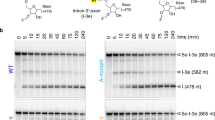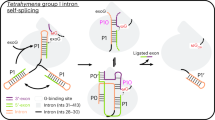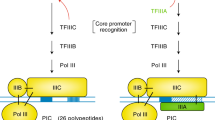Abstract
The origin of the eukaryotic nucleus marked a seminal evolutionary transition. We propose that the nuclear envelope's incipient function was to allow mRNA splicing, which is slow, to go to completion so that translation, which is fast, would occur only on mRNA with intact reading frames. The rapid, fortuitous spread of introns following the origin of mitochondria is adduced as the selective pressure that forged nucleus–cytosol compartmentalization.
This is a preview of subscription content, access via your institution
Access options
Subscribe to this journal
Receive 51 print issues and online access
$199.00 per year
only $3.90 per issue
Buy this article
- Purchase on Springer Link
- Instant access to full article PDF
Prices may be subject to local taxes which are calculated during checkout

Similar content being viewed by others
References
Gilbert, W. Why genes in pieces? Nature 271, 501 (1978)
Doolittle, W. F. Genes in pieces: Were they ever together? Nature 272, 581–582 (1978)
Darnell, J. E. Implications of RNA—RNA splicing in evolution of eukaryotic cells. Science 202, 1257–1260 (1978)
Doolittle, W. F. Revolutionary concepts in evolutionary cell biology. Trends Biochem. Sci. 5, 147–149 (1980)
Darnell, J. E. & Doolittle, W. F. Speculations on the early course of evolution. Proc. Natl Acad. Sci. USA 83, 1271–1275 (1986)
Cech, T. R., Zaug, A. J. & Grabowski, P. J. In vitro splicing of the ribosomal-RNA precursor of Tetrahymena—involvement of a guanosine nucleotide in the excision of the intervening sequence. Cell 27, 487–496 (1981)
Gilbert, W. The RNA world. Nature 319, 618 (1986)
Gilbert, W. The exon theory of genes. Cold Spring Harb. Symp. Quant. Biol. 52, 901–905 (1987)
Stoltzfus, A., Spencer, D. F., Zuker, M., Logsdon, J. M. & Doolittle, W. F. Testing the exon theory of genes: The evidence from protein structure. Science 265, 202–207 (1994)
Poole, A., Jeffares, D. & Penny, D. Prokaryotes, the new kids on the block. Bioessays 21, 880–889 (1999)
Forterre, P. & Philippe, H. Where is the root of the universal tree of life? Bioessays 21, 871–879 (1999)
Jeffares, D. C., Poole, A. M. & Penny, D. Relics from the RNA world. J. Mol. Evol. 46, 18–36 (1998)
Cech, T. R. The generality of self-splicing RNA: Relationship to nuclear mRNA splicing. Cell 44, 207–210 (1986)
Cavalier-Smith, T. Intron phylogeny: A new hypothesis. Trends Genet. 7, 145–148 (1991)
Ferat, J.-L. & Michel, F. Group II self splicing introns in bacteria. Nature 364, 358–361 (1993)
Roger, A. J. & Doolittle, W. F. Why introns-in-pieces? Nature 364, 289–290 (1993)
Cousineau, B., Lawrence, S., Smith, D. & Belfort, M. Retrotransposition of a bacterial group II intron. Nature 404, 1018–1021 (2000); correction 414, 84 (2001)
Lambowitz, A. M. & Zimmerly, S. Mobile group II introns. Annu. Rev. Genet. 38, 1–35 (2004)
Nixon, J. E. et al. A spliceosomal intron in Giardia lamblia. Proc. Natl Acad. Sci. USA 99, 3701–3705 (2002)
Tovar, J. et al. Mitochondrial remnant organelles of Giardia function in iron–sulphur protein maturation. Nature 426, 172–176 (2003)
Simpson, A. G., MacQuarrie, E. K. & Roger, A. J. Early origin of canonical introns. Nature 419, 270 (2002)
Vanacova, S., Yan, W., Carlton, J. M. & Johnson, P. J. Spliceosomal introns in the deep-branching eukaryote Trichomonas vaginalis. Proc. Natl Acad. Sci. USA 102, 4430–4435 (2005)
Hrdy, I. et al. Trichomonas hydrogenosomes contain the NADH dehydrogenase module of mitochondrial complex I. Nature 432, 618–622 (2004)
van der Giezen, M. & Tovar, J. Degenerate mitochondria. EMBO Rep. 6, 525–530 (2005)
Rogozin, I. B., Wolf, Y. I., Sorokin, A. V., Mirkin, B. G. & Koonin, E. V. Remarkable interkingdom conservation of intron positions and massive, lineage-specific intron loss and gain in eukaryotic evolution. Curr. Biol. 13, 1512–1517 (2003)
Roy, S. W. & Gilbert, W. Rates of intron loss and gain: Implications for early eukaryotic evolution. Proc. Natl Acad. Sci. USA 102, 5773–5778 (2005)
Collins, L. & Penny, D. Complex spliceosomal organization ancestral to extant eukaryotes. Mol. Biol. Evol. 22, 1053–1066 (2005)
Lynch, M. & Richardson, A. O. The evolution of spliceosomal introns. Curr. Opin. Genet. Dev. 12, 701–710 (2002)
Mans, B. J., Anantharaman, V., Aravind, L. & Koonin, E. V. Comparative genomics, evolution and origins of the nuclear envelope and nuclear pore complex. Cell Cycle 3, 1612–1637 (2004)
Cavalier-Smith, T. The phagotrophic origin of eukaryotes and phylogenetic classification of Protozoa. Int. J. Syst. Evol. Microbiol. 52, 297–354 (2002)
Staub, E., Fiziev, P., Rosenthal, A. & Hinzmann, B. Insights into the evolution of the nucleolus by an analysis of its protein domain repertoire. Bioessays 26, 567–581 (2004)
Doolittle, W. F. The origin of introns. Curr. Biol. 1, 145–146 (1991)
von Dohlen, C. D., Kohler, S., Alsop, S. T. & McManus, W. R. Mealybug β-proteobacterial symbionts contain γ-proteobacterial symbionts. Nature 412, 433–436 (2001)
Rivera, M. C. & Lake, J. A. The ring of life provides evidence for a genome fusion origin of eukaryotes. Nature 431, 152–155 (2004)
Martin, W. & Müller, M. The hydrogen hypothesis for the first eukaryote. Nature 392, 37–41 (1998)
Vellai, T., Takács, K. & Vida, G. A new aspect on the origin and evolution of eukaryotes. J. Mol. Evol. 46, 499–507 (1998)
Finlay, B. J. & Fenchel, T. An anaerobic ciliate as a natural chemostat for the growth of endosymbiotic methanogens. Eur. J. Protistol. 28, 127–137 (1992)
Doolittle, W. F. You are what you eat: A gene transfer ratchet could account for bacterial genes in eukaryotic nuclear genomes. Trends Genet. 14, 307–311 (1998)
Lynch, M. & Conery, J. S. The origins of genome complexity. Science 302, 1401–1404 (2003)
Khusial, P., Plaag, R. & Zieve, G. W. LSm proteins form heptameric rings that bind to RNA via repeating motifs. Trends Biochem. Sci. 30, 522–528 (2005)
Sorensen, M. A., Kurland, C. G. & Pedersen, S. Codon usage determines translation rate in E. coli. J. Mol. Biol. 207, 365–377 (1989)
Audibert, A., Weil, D. & Dautry, F. In vivo kinetics of mRNA splicing and transport in mammalian cells. Mol. Cell. Biol. 22, 6706–6718 (2002)
Palmiter, R. D. Quantitation of parameters that determine the rate of ovalbumin synthesis. Cell 4, 189–197 (1975)
Levine, T. & Rabouille, C. Endoplasmic reticulum: One continuous network compartmentalized by extrinsic cues. Curr. Opin. Cell Biol. 17, 362–368 (2005)
Reed, R. & Hurt, E. A conserved mRNA export machinery coupled to pre-mRNA splicing. Cell 108, 523–531 (2002)
Luo, M. L. et al. Pre-mRNA splicing and mRNA export linked by direct interactions between UAP56 and Aly. Nature 413, 644–647 (2001)
Fasken, M. B. & Corbett, A. H. Process or perish: Quality control in mRNA biogenesis. Nature Struct. Mol. Biol. 6, 482–488 (2005)
Maquat, L. E. Nonsense mediated mRNA decay: Splicing, translation and mRNP dynamics. Nature Rev. Mol. Cell Biol. 5, 89–99 (2004)
Anantharaman, V. & Aravind, L. New connections in the prokaryotic toxin–antitoxin network: Relationship with the eukaryotic nonsense-mediated RNA decay system. Genome Biol. 4, R81 (2003)
Iborra, F. J., Jackson, D. A. & Cook, P. R. Coupled transcription and translation within nuclei of mammalian cells. Science 293, 1139–1142 (2001)
Dahlberg, J. E. & Lund, E. Does protein synthesis occur in the nucleus? Curr. Opin. Cell Biol. 16, 335–338 (2004)
Cosson, B. & Philippe, M. Looking for nuclear translation using Xenopus oocytes. Biol. Cell. 95, 321–325 (2003)
Heath, I. B. Variant mitoses in lower eukaryotes: Indicators of the evolution of mitosis? Int. Rev. Cytol. 64, 1–80 (1980)
Gabaldó;n, T. & Huynen, M. A. Reconstruction of the proto-mitochondrial metabolism. Science 301, 609 (2003)
Makarova, K. S., Wolf, Y. I., Mekhedov, S. L., Mirkin, B. G. & Koonin, E. V. Ancestral paralogs and pseudoparalogs and their role in the emergence of the eukaryotic cell. Nucleic Acids Res. 33, 4626–4638 (2005)
Yang, S., Doolittle, R. F. & Bourne, P. E. Phylogeny determined by protein domain content. Proc. Natl Acad. Sci. USA 102, 373–378 (2005)
Adl, S. M. et al. The new higher level classification of eukaryotes with emphasis on the taxonomy of protists. J. Eukaryot. Microbiol. 52, 399–451 (2005)
Acknowledgements
We thank the DFG (W.M.) and the NIH intramural research program (E.V.K.) for financial support, and M. Embley, T. Dagan, I. Rogozin, T. Senkevich and Y. Wolf for discussions.
Author information
Authors and Affiliations
Corresponding author
Ethics declarations
Competing interests
Reprints and permissions information is available at npg.nature.com/reprintsandpermissions. The authors declare no competing financial interests.
Rights and permissions
About this article
Cite this article
Martin, W., Koonin, E. Introns and the origin of nucleus–cytosol compartmentalization. Nature 440, 41–45 (2006). https://doi.org/10.1038/nature04531
Issue Date:
DOI: https://doi.org/10.1038/nature04531
This article is cited by
-
Obligate endosymbiosis enables genome expansion during eukaryogenesis
Communications Biology (2023)
-
Origin of the nuclear proteome on the basis of pre-existing nuclear localization signals in prokaryotic proteins
Biology Direct (2020)
-
The Syntrophy hypothesis for the origin of eukaryotes revisited
Nature Microbiology (2020)
-
Multidomain ribosomal protein trees and the planctobacterial origin of neomura (eukaryotes, archaebacteria)
Protoplasma (2020)
-
Mosaic mitochondrial-plastid insertions into the nuclear genome show evidence of both non-homologous end joining and homologous recombination
BMC Evolutionary Biology (2018)
Comments
By submitting a comment you agree to abide by our Terms and Community Guidelines. If you find something abusive or that does not comply with our terms or guidelines please flag it as inappropriate.



